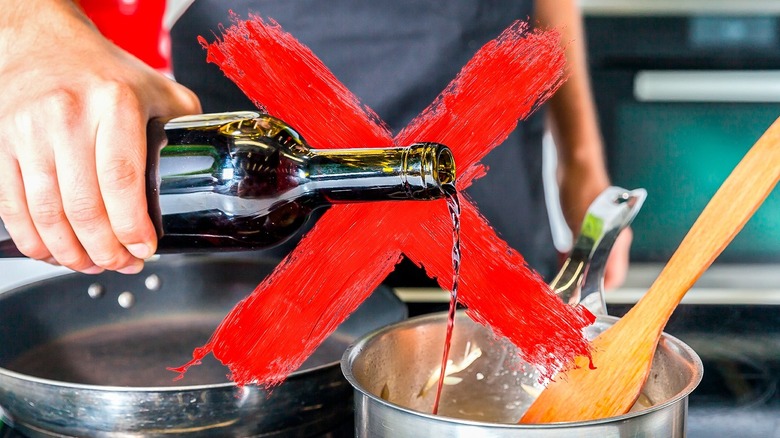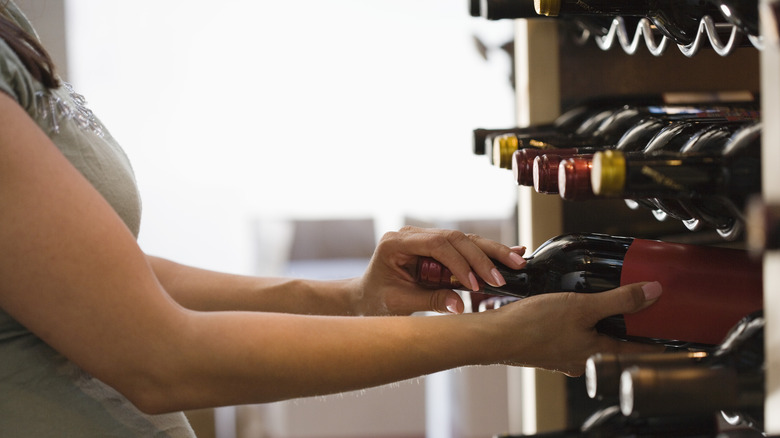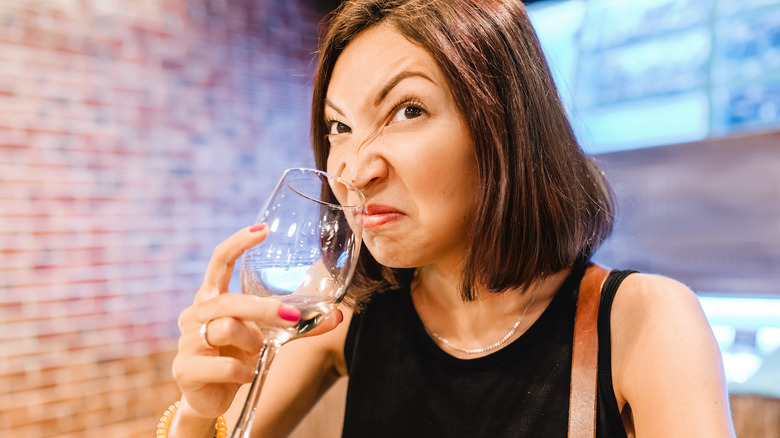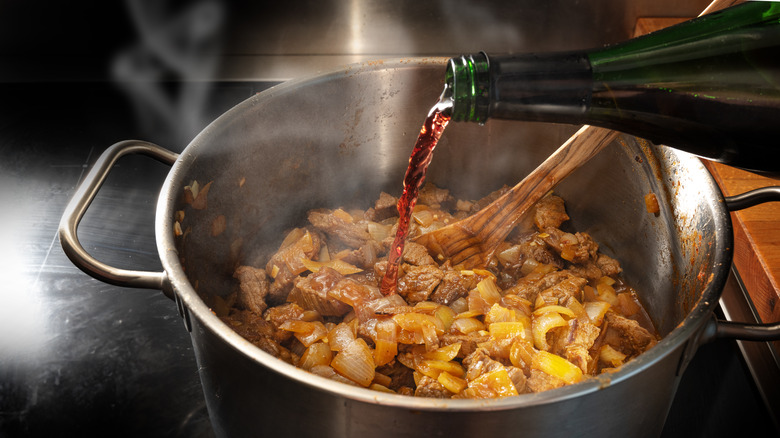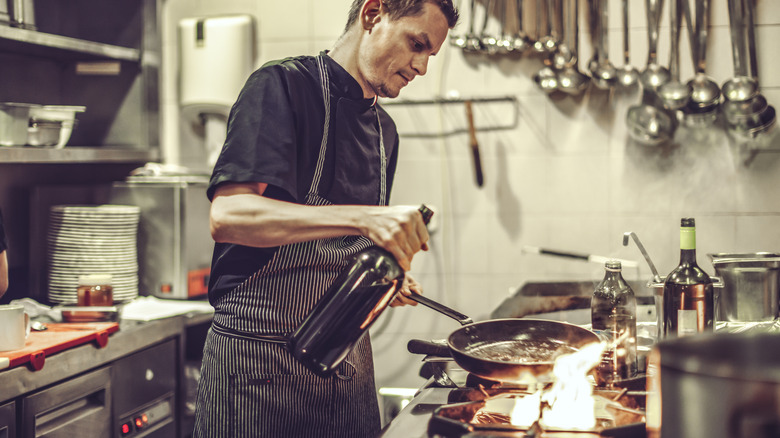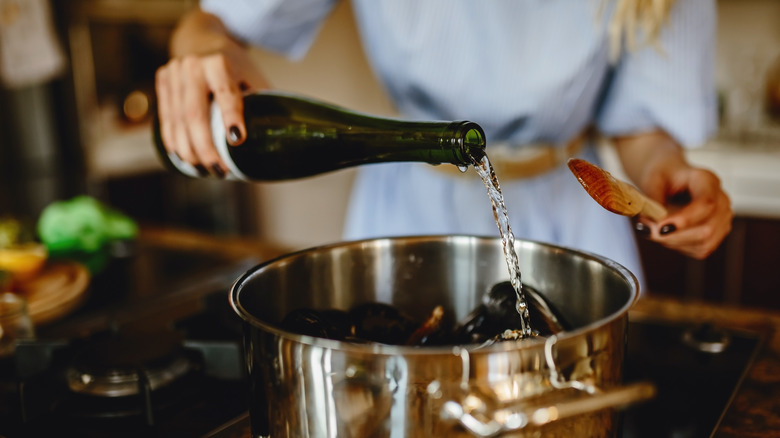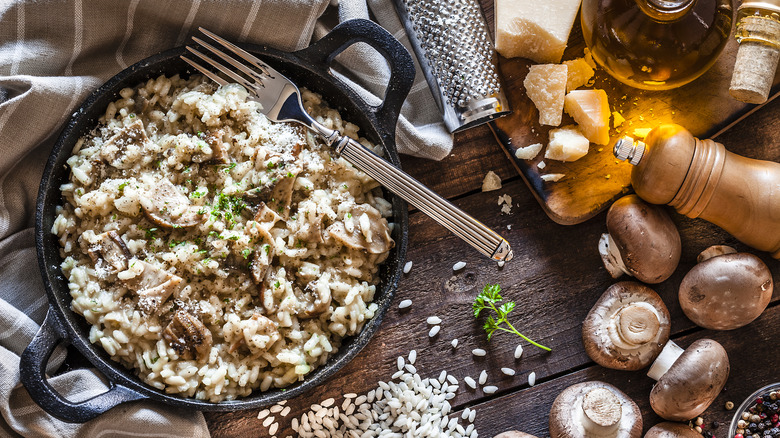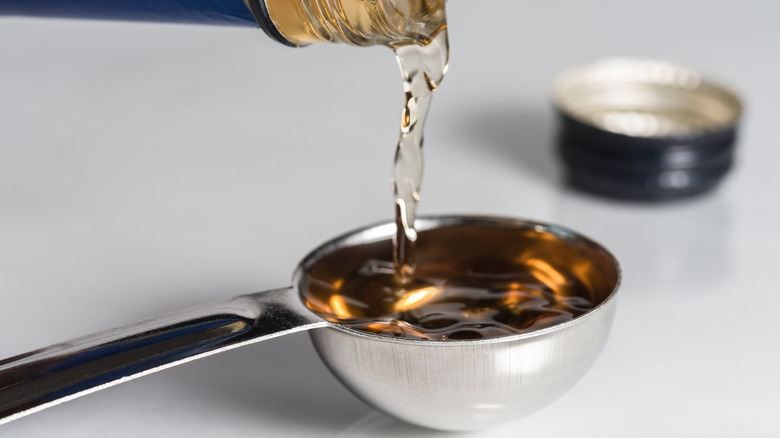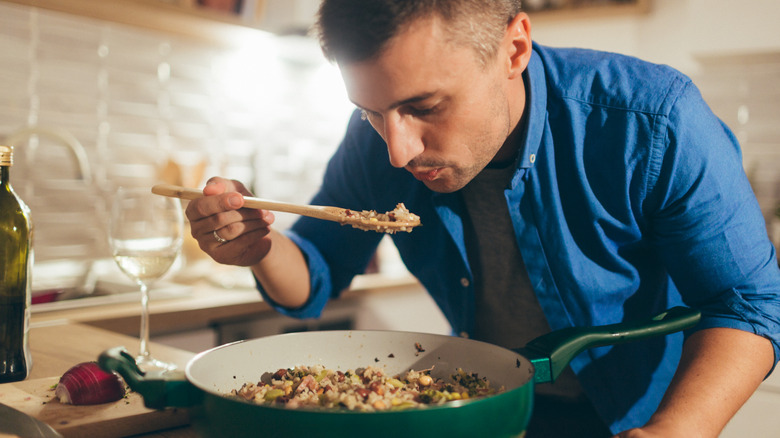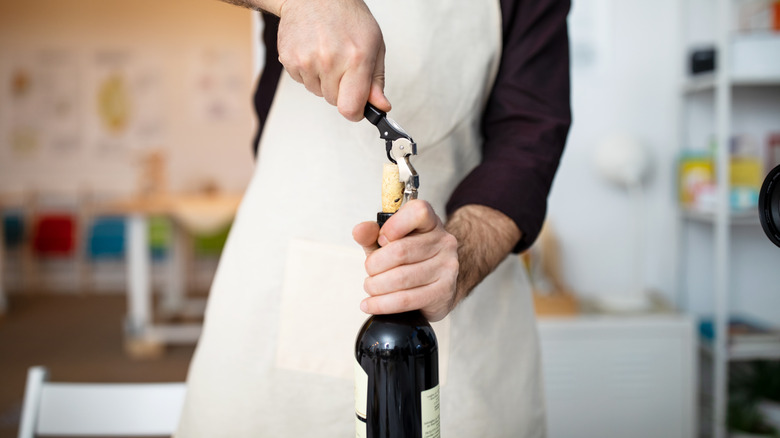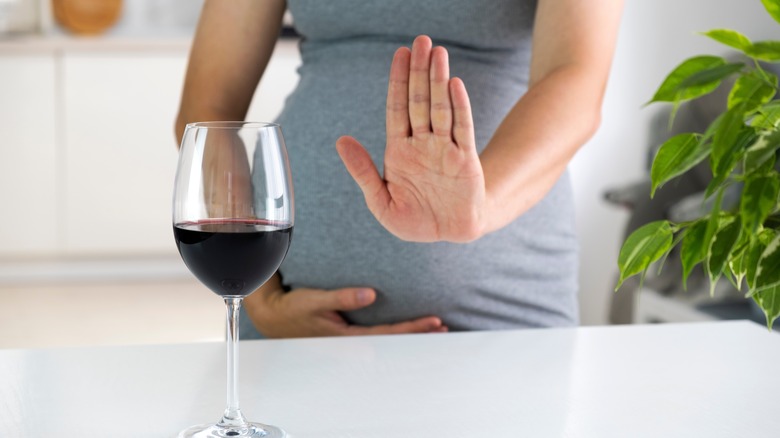14 Mistakes Everyone Makes When Cooking With Wine
Even if you're not a wine drinker, there's a strong chance you've loved a dish that used the grape-based alcoholic beverage as an ingredient. When used correctly, wine can infuse a dish with its complex and nuanced flavors, bring balance to a recipe, contrast with other ingredients, or do all of the above.
That being said, as a cooking ingredient, wine can be more complex than you might think. There are many different aspects to wine that all have to be understood and applied when choosing the perfect one to enhance your dish. Without knowing the basics, sooner or later, you'll end up adding a wine that ruins a dish or, at the minimum, prevents it from reaching its full potential. It's something I've seen time and time again working and managing professional kitchens and experimenting at home. Below are some of the most significant mistakes people tend to make when cooking with wine, and I know I've been guilty of one or two of them myself in the past, so let's learn about what not to do.
Choosing the wrong wine
It should go without saying that not all wines are the same. For starters, you've got broad wine categories like whites, reds, rosés, and sparkling.
You can also break wines down by the grapes used, the production methods, and the terroir — all of which change how a wine tastes. There are dry wines, sweet wines, tannic wines, acidic wines, flavored wines, fortified wines... the point is, if a recipe calls for wine, the type matters. Typically, white wines are used for lighter dishes that use chicken or fish or have a citrus element, while reds are usually added to beef-based recipes. There are exceptions – a dry, medium-bodied red is the best style to use in traditional French onion soup, for example — but the rule of thumb is to use a wine that you'd pair with the core ingredients of the dish if you were drinking it from a glass. There are some wine varieties you probably want to avoid cooking with altogether, but as long as you bear in mind sweetness, acidity, and flavor profile, your choice will complement your other ingredients instead of clashing.
Using low-quality wine
Many folks assume that because it's being heated up and combined with other ingredients, the quality of cooking wine really doesn't matter much. It's not an unreasonable assessment to make, but it is an inaccurate one.
The truth is that if you care about the quality of your dish then you should care about the quality of your wine, and if it's not a wine you'd drink on its own then you shouldn't be cooking with it. That's not to say you need to be splashing out on top-shelf bottles for your kitchen, but it should still be palatable. You can still use box wine — in fact, most restaurants do because it's more cost-effective — but it should be drinkable box wine and not some of the bottom-shelf swill that you'll find for a few bucks in dodgy liquor stores. If the bottle or box is labeled specifically as "cooking wine," it's best to give it a miss, as these usually contain unnecessary additives and aren't the sorts of wine you'd want to drink on their own.
Using too much wine
Much like how drinking too much wine can be a bad idea, the same rule applies to cooking with it. Although some wines have a more delicate taste than others, most are somewhat intense when compared to other cooking ingredients.
Different recipes call for different quantities of wine, with some just needing a splash or two for seasoning and others calling for nearly a whole bottle, so try not to rely on guesswork with your recipe. Not only can too much wine overpower a dish, but it can also make it taste too boozy, a quality of wine that most people tend to try and avoid in most dishes. To find the perfect balance, it's best to add it bit by bit and taste as you go — you can always add more wine, but you can't take it back. That's not to say there aren't ways to fix your dish if you've added too much wine, but you'll save yourself time and hassle if you get it right the first time.
Using expired wine
It's not uncommon to hear people talk about saving leftover wine for cooking, which isn't necessarily something to avoid. If the wine is still good to drink but you're choosing not to, then it's fine to cook with; however, if you're not drinking the wine because it's past its best, then you're better off pouring it down the sink.
Wine spoils just like most other ingredients, and adding it to your dish is no different than if you were to add spoiled vegetables. Expired wine isn't likely to make you sick — that's not to say that it can't — but the unpleasant aromas and flavors that develop will definitely be passed on to your food. If you're saving wine for cooking, make sure to pop the cork or a stopper back in and store it in the fridge to keep it fresher for longer. After five days, it's likely time to throw it out. For corked bottles, consider that not all wines age the same way. Some bottles can be cellared for decades, but many aren't suited for extended aging – most unopened wines don't last nearly as long before spoiling.
Not allowing wine to cook off
The reason we don't normally worry about getting tipsy from food with wine as an ingredient is that we've heard that almost all of the alcohol burns off during cooking. However, "almost," is not the same as "all."
In fact, most people wildly overestimate the amount of alcohol that evaporates during cooking. If you're cooking something for around two and a half hours, about 5% of the alcohol that was added will remain – we could probably consider this amount of alcohol as negligible. However, just half an hour less, and the remaining alcohol is around 10%. Fifteen minutes of cooking will only evaporate just over half of the booze in the recipe. The temperature you're using will affect the amount of alcohol that's burned off — higher heat will evaporate alcohol more quickly — and pans with a larger surface area also help. The main point is that unless your dish is supposed to have a boozy quality to it, you'll need to make sure you're cooking it for long enough to avoid the potentially unwelcome ethanol flavor.
Adding wine too late
Another common error people make when cooking with wine is adding it too late. Getting the timing right is important for a few reasons.
We touched on the first one above — if you add alcohol too late into the cooking process, it won't have enough time to burn off and it will end up throwing off the balance of flavors in the dish. The wine also needs time to meld with the other ingredients as they infuse with one another and create the complex flavor profile we're seeking, so if you add it in too late, you're missing out on the wine's full potential. Wine is also acidic, which we'll look at more closely in a moment, but this acidity does more than affect the taste of the dish. If you're cooking with meat — let's say you're making a rich, beef stew, for example — then the wine will help to keep the meat moist while its acidic properties will tenderize the beef so it becomes nice and tender. Typically, you want to add wine at the same time as the rest of your wet ingredients. However, always check the recipe as this isn't always the case — some dishes, like risotto, require the wine to be added bit by bit instead rather than all at once.
Not considering the wine's acidity
All wines can be considered acidic, and it's this property that makes wine such a popular ingredient, aside from the extra flavor. We've already mentioned its tenderizing qualities, but acid also plays a crucial role in balancing flavors.
That being said, different styles of wine have varying levels of acidity, so you'll need to factor this in before you pop open a bottle to add to your dish. In general, white wines are more acidic than reds, but we already know these aren't typically interchangeable in cooking. High acidity wines — such as riesling or Chenin blanc for whites, and pinot noir or gamay for reds — introduce brighter, more tart flavors to a dish. They're also better at cutting through rich and fatty ingredients in a recipe. On the other hand, lower acidity wines — think chardonnay for whites, and Malbec, cabernet sauvignon, and merlot for reds — are better for more delicate dishes. Bear in mind this is a rough guide, as styles will still differ from region to region.
Skipping wine altogether
Recipes that call for wine almost always do so with good reason. Many see it as an optional ingredient and if they're fresh out, are happy to continue cooking without it.
If using wine is not an option for whatever reason, you should always try and find a substitute that can fill its role. That being said, if we can't use the same wine for every dish, we certainly can't use the same substitute, so it matters which alternative — or alternatives — you choose. If the wine is there to provide a depth of flavor, then stock or bouillon cubes should be a suitable replacement. For acidity, wine vinegar can work wonders, and for sweetness, fruit juice is the way to go — usually something with similar flavors such as apple or grape. Tomato sauce or purée can add both richness and acidity, while a few drops of soy or Worcestershire sauce can add umami to the dish. For white wine, you can usually substitute it with broth with one small tweak. Experiment to find out which substitutes work best for your palate, and you may even find that the right combination results in an even tastier dish than if you'd used wine.
Using flavored or seasoned wines inappropriately
So far, we've generally been talking about cooking with typical red or white wines, but this only scratches the surface. Seasoned or flavored wines, like mulled wine, can be delightfully complex ingredients that work wonders in both sweet and savory dishes.
We've also got heaps of fortified wines, like sherry, Madeira, Port, and Marsala. These are wines where more alcohol — usually a grape-based spirit — has been added back in to give them stronger, sweeter, and more flavorful characteristics. They can have a profound impact on how a dish tastes, like in Tasting Table's fall-inspired risotto which uses Marsala wine to add a nutty, caramelized twist to the classic recipe. However, the extra intensity of these styles of wine means that using the wrong one is far more likely to ruin a dish than if you were to mix up regular styles of the same color. Only use flavored or fortified wines if the recipe calls for it, and remember that fortified wine styles vary greatly. If a dish needs sherry, don't use Marsala, and be aware that even these styles can have both sweet and dry varieties that have big differences in how they taste.
Not considering sweetness
Along with the taste profile and acidity, the inherent sweetness of a wine is crucial for achieving a proper balance of flavors in a dish. First, we need to discuss the meaning of the word "dry" when referring to wine.
People frequently assume that when we call a wine dry, we're talking about the drying sensation that some wines have inside our mouths; however, this isn't quite accurate. This effect is the result of tannins, something we'll get to in just a moment. In reality, if a wine is dry, it means that it's unsweet. The drier, the wine, the less residual sugar there is in the finished product. Sweetness can be a little trickier to perceive in wine than many people realize, as some wine qualities deceive our palates. For example, it's not unusual to perceive fruity flavors as sweet, as we commonly associate fruit with sweetness. However, a wine can be dry and fruity, and if you add it to a dish that calls for a sweet wine, it will mess with the balance of the ingredients. If the bottle isn't clear about whether the wine is dry or sweet, a taste test might be called for. Sweet wines usually have a higher viscosity and a slightly oily texture on the tongue, and they'll tingle the tip of your tongue, too.
Overlooking tannins
Along with sweetness and acidity, tannins are one of the most important aspects of wine. They're a type of molecule that's found in the skins, stems, and seeds of grapes, as well as the oak in which wine is commonly aged.
Although white wines can be tannic, tannins are predominantly found in red wines. This is because red wines ferment the grape skins along with the insides of the grapes, which is how they differ from white wines. Tannins present an astringent quality that can make it feel like the moisture is being sucked out of your mouth, which is why people sometimes incorrectly use the term "dry" to refer to tannic wines. Wines with bold tannins are generally best served with food or used in cooking. They can be great for pairing with fatty foods, like a well-marbled steak or cured meats, but they'll overpower lighter flavors. They also don't play nicely with salty or citrusy ingredients because they enhance the bitterness of the recipe, potentially to the point of being unpalatable.
Ignoring wine reduction
To increase the intensity of flavors in a recipe, it's not uncommon to use a technique known as reduction. Reduction works by boiling or simmering certain liquids so that some of their water content evaporates and they become stronger and more concentrated.
Wine is often reduced in dishes as it helps thicken the consistency of the liquid, which is perfect for creamier sauces and richer stews, and for amplifying the wine's unique characteristics. However, the more water we remove from a liquid, the saltier it begins to taste. Some of the flavors can also become too intense and overpowering. If you do reduce the wine too much to the point that it's stealing the limelight from the other ingredients, there's a simple fix — simply replace the water that's evaporated. Add the water incrementally, and you'll be able to rebalance the flavors back to the point you want them.
Not matching wine with the cuisine
While it's entirely possible to pair wines from one country with cuisine from another, it's something that can be hard to get right without experience. If you're using wine as an ingredient and want to be on the safe side, try to match up the origin of the food with the origin of the wine.
For example, if you're cooking up a rich tomato bolognese of hearty beef stew, an Italian red like Sangiovese or Chianti is going to be your best bet for imbuing your sauce with deep, earthy undertones. For French coq au vin, a Burgundy pinot noir or Côtes du Rhône is the way to go, while lighter dishes will benefit from a fruity and floral sauvignon blanc. You've also got international styles of wine, such as sake or plum wine, that are superb when used in Asian-inspired dishes, but will likely be very out of place in, say, Spanish food. Countries can produce a wide range of wine styles, so this doesn't mean you should ignore any of the tips above and that matching by country of origin is enough. It's just another factor to bear in mind for choosing the best wine for the job.
Not considering wine sensitivities and personal preferences
When we're cooking with alcohol, particularly wine, it's important that we think about the people we're cooking for. For people who can't consume any alcohol, we should find a substitute, because we now know that it's inaccurate to claim all alcohol is removed during cooking.
Some folks just don't consume alcohol out of personal preference, pregnancy, or due to addiction, while others may have religious beliefs that prevent them from imbibing in any fashion. Looking specifically at wine, there are some allergens that might cause issues. Sulfites are a potential allergen that occurs naturally in wine but is also supplemented to help with preservation. Dairy, another allergen, can also sometimes be used in the fining process to filter particulates out of wine, so it's worth checking the bottle for more details. While you might assume wine is vegan, some producers still use fish-based products as fining agents, and while you'll never taste anything fishy, it won't be suitable for a plant-based diet or someone who's allergic to fish. We already covered suitable substitute ingredients, but you might also want to look into non-alcoholic wines as another option.
